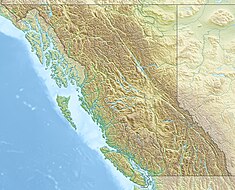| W. A. C. Bennett Dam | |
|---|---|
 The W. A. C. Bennett Dam, taken from the viewpoint | |
| Location | Hudson's Hope, British Columbia, Canada |
| Coordinates | 56°01′00″N 122°12′02″W / 56.01667°N 122.20056°W |
| Construction began | 1963 |
| Opening date | 1968 |
| Owner(s) | BC Hydro |
| Dam and spillways | |
| Type of dam | Embankment dam |
| Impounds | Peace River |
| Height | 186 m (610 ft) |
| Length | 2,068 m (6,785 ft) |
| Spillway capacity | 9,205 m3/s (325,100 cu ft/s) |
| Reservoir | |
| Creates | Williston Lake |
| Total capacity | 74 km3 (60,000,000 acre⋅ft) |
| Surface area | 1,761 km2 (680 sq mi) |
| Power Station | |
| Turbines | 10 |
| Installed capacity | 2,907 MW[1] |
| Capacity factor | 58.9% |
| Annual generation | 15 TWh (54 PJ) [2] |
The W. A. C. Bennett Dam is a large hydroelectric dam on the Peace River in northern British Columbia, Canada. At 186 metres (610 ft) high, it is one of the world's highest earth fill dams. Construction of the dam began in 1961 and culminated in 1968.[3] At the dam, the Finlay, the Parsnip and the Peace rivers feed into Williston Lake, also referred to as Williston Reservoir. It is the third largest artificial lake in North America (after Smallwood Reservoir and Manicouagan Reservoir) as well as the largest body of fresh water in British Columbia.[4] Williston Lake runs 250 kilometres north–south and 150 kilometres east–west.
The construction of the dam cost $750 million, making it the largest project of its kind in the province of BC.[5] The dam was named after Premier W. A. C. Bennett because his vision played a major role in the project initiation, development, and realization; the reservoir was named after the premier's trusted cabinet colleague: Ray Williston.[5] The Gordon M. Shrum Generation Station at the W. A. C. Bennett Dam has the capacity to generate more than 13,000 GWh annually, at times supplying over a third of B.C's power demand.[6] At the time of its construction the powerhouse was the largest of its kind worldwide; it continues to be the largest power station in B.C and it is the third largest hydroelectric development in Canada after Robert-Bourassa and Churchill Falls.[6]
In addition to the benefits related to the clean energy generated, the construction of the dam and the reservoir also provided economic opportunities for the province of British Columbia, for the newly founded provincially owned electric utility BC Hydro, and for the large number of workers. These workers were involved in the planning, construction, operation, and maintenance of the project. Considerable costs were involved in the government funded project, the clearing of the area for the reservoir, called the Trench, alone cost $5 million.[7]
The building of the dam and the reservoir were not without controversy. One controversy was caused by the significant negative environmental effects the project had on the immediate environment. In the process of creating Williston Lake, 350,000 acres of former forest land was flooded.[8] This caused the loss of plant and wildlife biodiversity as well as risking mineral and timber rights.[8]
A second controversy related to the fact that the land had been inhabited prior to its flooding, therefore the flooding resulted in the displacement of the forty or fifty residents located in the Trench. Among them were members of the Tsay Keh Dene First Nation, then known as Ingenika.[8] The displacement had negative social impacts on the inhabitants as the loss of the land that had previously supported them meant loss of autonomy and resulted in isolation, alienation, and "social disorganization".[9] A BC Hydro consultant admitted in 1977 that the 'isolation imposed by the reservoir had severe impacts on Ingenika society and culture".[10]
- ^ "Peace Region". BC Hydro. Archived from the original on March 30, 2020. Retrieved April 28, 2020.
- ^ van Groll, Jonathan (July 3, 2018). Value of pumped storage systems in British Columbia (Thesis). University of British Columbia. p. 117. doi:10.14288/1.0368788. Archived from the original on February 15, 2020. Retrieved April 28, 2020.
- ^ Loo 2007, p. 372.
- ^ Stanley 2010, p. 3.
- ^ a b Mitchell 1994, p. 372.
- ^ a b BC Hydro. "W.A.C. Bennett Dam Visitor Centre". Retrieved March 12, 2012.
- ^ Stanley 2010, p. 66.
- ^ a b c Loo 2007, p. 901.
- ^ Loo 2007, p. 905, 906.
- ^ Loo 2007, p. 906.
